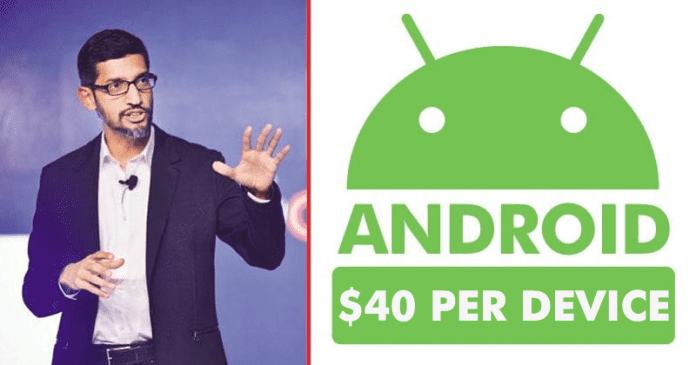

We all know very well that Android is the most widely used mobile operating system on the market, hence, it is subject to scrutiny and constant assessment by regulators from the countries where it is present. However, now according to the latest reports, the tech giant Google will charge $40 per device for Android.
Google To Charge $40 Per Device For Android
The fine imposed by the European Union has made the tech giant Google change the rules of the game: now the company, of course, the tech giant Google will charge a licensing fee for manufacturers that include certain Google applications on their smartphones. It was not clear what the charge would be, but The Verge had access to documents that reveal that the charge could be as high as $40 per device.
Anti-competitive practice
If you are out of the question, here is a brief recap: in July the European Commission fined the tech giant Google for understanding that the company took advantage of Android’s market leadership to force distribution of the search application and Chrome on the various smartphones manufacturers. In exchange, the tech giant Google provided these companies with a license to access the Play Store at no cost.
These practices were considered anti-competitive by the European Commission, because, in the words of the entity, “denied rivals the chance to innovate and compete on merits.” Although it is appealing the fine, the tech giant Google decided to change its licensing rules to comply with the determinations of the European authorities.
Also Read: Top 20+ Ultimate Hidden Tricks and Features Of Android
This is where the issue of license collection appears. Android itself, when treated solely as an operating system, has open source and zero cost as long as there is no Google app in preinstallation. But to make it minimally usable to the user, you need to include applications and services. But these tools are not free or open source, hence, it is necessary to license them.
In the agreements established until recently, the following condition prevailed: the manufacturer who wanted to insert a Google application into their device (for example, the search engine) could do so if it installed everything else like Chrome, Maps, To Do, among many others. In return, there was no charge for licensing.
But that was not the only rule, as the tech giant, Google allowed the installation of competing applications. If a manufacturer wanted to distribute the Bing app, for example, it would have to position the Google search engine on the Android home screen. This is what the European Commission has played, essentially.
As a precaution, the tech giant Google is treating the matter with secrecy, but the documents obtained by The Verge indicate that this licensing scheme will be kept optional. If a manufacturer wants to install Google applications but does not follow the conditions of the company, it can do so, but paying for licensing.
The default package value – which includes the Play Store – will depend on the region. In countries such as Germany, the Netherlands, and Norway, manufacturers will have to pay the equivalent of $40 per device on models with more than 500 ppi on the screen, $20 on units with pixel density between 400 and 500 ppi, and $10 on devices with less than 400 ppi.
In other countries, however, the minimum rate may be as low as $2.50 per unit. In the case of tablets, the license was standardized at the US $20 for the whole European Union. It is possible to negotiate all these fees, especially if the manufacturer does not want to include certain Google applications, but agree to pre-install the search engine and Chrome.
Why did Google decide to charge for the licenses?
What draws attention to this story is that the tech giant Google was not required to charge for the licensing. What the European Commission has determined is that the company is more flexible about the requirements for distributing its applications.
But because the search engine and Chrome are the company’s top revenue streams on mobile devices, billing is a way to compensate for any missing apps.
Also Read: 30 Best Tips And Tricks For Rooted Android Device
Another form of compensation is non-revenue sharing: the documents also show that if the manufacturer chooses not to install Chrome from the factory or does not put it on the bottom of the system, it will not receive any revenue from displaying ads on the browser (even if Chrome is supposed to be installed by the user, presumably).
So far, the tech giant Google has not publicly commented on the issue. The fear is that it will be left over for the user to pay the bill, or there will be a rise in the prices of smartphones. It remains to be hoped that, in the end, the tech giant Google and manufacturers will make deals favorable to everyone. So, what do you think about this? Simply share all your views and thoughts in the comment section below.


